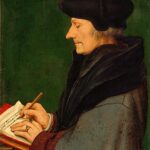Nowadays, many doctors prescribe walks in nature instead of medication or recommend a hike. The beneficial effects may be even more significant if a hike begins unexpectedly in a philosophically designed environment. This is even more true if mythical mountains, waterfalls, streams, and wooded hills form the snowy landscape.


The Eigenthal Even mythical mountains are entitled to privacy and sometimes shroud themselves in clouds. The Pilatus chooses its days and moments.
Only a few restaurants welcome guests with a history of philosophy and celebrities from ancient times to the present. As we know, almost every village in Switzerland has cultural, historical, or natural peculiarities.

Schwarzenberg
However, coffee with gipfeli under the watchful eyes of Socrates, Copernicus, Churchill or the Pilatus is exceptional. On the outskirts of the village of Schwarzenberg (canton of Lucerne), however, a Hotel-Bildungszentrum complex links the pleasant with the useful.




The village along the Rümlig stream lies at an altitude of 831 metres in the Eigenthal at the foot of the Pilatus. Around 10,000 years ago, the temperature sharply rose, and the Rümlig glacier in the valley turned into a lake. This lake silted up in the following millennia, and humans started cultivating the valley.

Eigenthal first appears in a document from 1287 under the name Oegenthal. Murbach Monastery in Lucerne owned it for centuries, and eventually, the city of Lucerne acquired the area.
From 1850 onwards, the English introduced mountaineering and winter sports to many places in Switzerland. However, Eigenthal’s development into a renowned winter sports resort is ‘homemade’.
Residents of Lucerne founded the Lucerne Ski Club in 1903, and the Eigenthal and Pilatus were the favourite destinations. Residents of Schwarzenberg founded the Schwarzenberg ski club in 1925. In 1943, some members split off and called themselves Ski Club Eigenthal.
The old club Schwarzenberg changed its name to Ski Club Malters because most of its members lived in this municipality. Eigenthal then wanted the name Ski Club Schwarzenberg back, but Ski Club Malters did not allow it.
It led to a unique case that led to the highest level of the national ski federation. After a four-year (!) procedure, an arbitral tribunal decided that the new club Malters had wrongfully stopped the (re)use of the name Schwarzenberg.
This club even had to pay high damages. Socrates had not yet arrived in the valley. Today, the Schwarzenberg and Malters ski clubs are back on ‘speaking terms’ and organise annual competitions and meetings.
Eigenthal even had its ski jump, die ‘Grosse Pilatusschanze,’ until 1949. Moreover, several national cross-country skier championships, ’50-km-Dauerlauf, ‘ took place in Eigenthal from 1929 to 1966.

An astronomer in the Eigenthal
The valley not only hosts facilities for summer and winter sports. As is well known, ‘light pollution’ in the mountains is considerably lower than in urban areas. Consequently, astronomers often envision a bright universe, and Eigenthal offers this opportunity.
The road to the Pilatus and its mountain range offers views of the city of Lucerne, the Reuss, Lake Lucerne, the Rigi, and the Bürgenstock, including the Swiss livestock.

The Pilatus and the Rigi also make impressive appearances in Lucerne. Unsurprisingly, the greatest composers felt at home in this area: Richard Wagner (1813-1883) on one side of the shore and Sergei Rachmaninoff (1843-1943) on the other side of the lake.


The Pilatus, viewpoint Eigenthal

The Pilatus, viewpoint Lucerne

The Rigi, viewpoint Lucerne


Lucerne

The Postauto, always ‘pünktlich’ at your service, wherever you go
The Swiss Alpine Club
The Swiss Alpine Club (Schweizer Alpen Club, SAC/Club Alpin Suisse, CAS) regularly organises hikes in this area and elsewhere in the country.
(Further information: www.sac-cas.ch)
Impressions of the Eigenthal


Freely accessible Farmershop (Hofladen) and Swiss civil society






Lady in waiting and the most famous Englishman, Hotel & Bildungszentrum Matt

Chapels everywhere in the catholic canton














